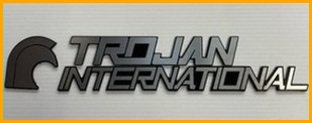

Trojan Yachts was founded back in 1949, at which time they built a small selection of wooden racing boats and runabouts in their facility in Troy, NY. The company eventually moved the operation to Pennsylvania, where they had access to a local Amish workforce. By the 1950s, Trojan was producing some 20 boats a week. In the 1960s, it grew even further with the acquisition of the Shepard Boat Company, a Canadian builder of wooden motor yachts up to 50 feet in length.
Trojan went on to grow from there, eventually introducing a series of popular fibreglass models, including the revolutionary International Series — which made its debut in 1981.Today we’re going to take a look at one of these popular models, the Trojan 10M Express.
The 10 Meter Mid-cabin was introduced in 1986. Our test boat was manufactured the following year. Trojan also manufactured the 10 Meter Express, a very similar model sporting the same solid fibreglass hull, but offering a slightly different interior layout — the most notable difference being the lack of a mid- cabin. Both models featured Trojan’s somewhat unique DeltaConic hull with a moderate transom dead rise of nine degrees.
One of the most notable features of International Series models is the generous beam. With a length of 33 feet and a beam of 13 feet, skeptics initially thought the Trojan 10M was just too wide. That, in combination with its glitzy Euro-styling, had many thinking this style of boat would not catch on. Well, Trojan went on to prove the skeptics wrong. This model, along with several others in the International Series, went on to have a lengthy production run.
Although this particular model lacks a transom door, there is a notch cut out of the transom to allow easier access to the aft deck area. Thanks to the generous beam, the bi-level cockpit is very spacious. Back aft, a large bench seat runs the full width of thecockpit and there’s plenty of room for folding chairs and a table. Off to port you’ll find a large wet bar featuring alarger-than-average bar fridge, a large sink and ample storage. Our test boat sported full camper back canvas, so you and your guests will be able to lounge in this area no matter what the weather is doing outside. Another nice feature is the easy access to the engine compartment via the large hatches in the cockpit sole.
On the upper level of the cockpit, there is a large double bench seat for passengers to port and a similar sized bench seat to starboard in the helm area. The helm itself, in my opinion, is rather cumbersome looking, with beefy engine controls mounted to the top of the dash on either side of the vertically mounted steering wheel. That being said, it is very functional and there is plenty of room for electronics and other accessories. In 1989, Trojan made a few design changes to this model, including a new Euro-style instrument panel.
A large sliding door amidships provides easy access (and ample natural light) to the main salon. Off to port there is a large dinette that can be converted to a double berth. To starboard, you’ll find a spacious galley with an under-counter refrigerator, two-burner alcohol/electric stove, coffee maker and double sink. The main electrical panel and generator controls are also found here.
For overnight accommodation, the master stateroom forward features a double berth and plenty of storage areas throughout. This cabin also sports a privacy door — not a curtain — and there is also direct access to the spacious head that features a separate shower stall. Additional sleeping quarters for two guests can be found in the mid-cabin, which also features a double berth and its own privacy curtain.
Our test boat was powered by a pair of 454-ci Crusaders, which is standard power for this model. Running solo with the fuel tanks 3⁄4 full, the 10 M climbed on plane in a respectable 5.8 seconds. With the tachometers reading 3300 rpm, we cruised comfortably at 20.9 mph. On most express cruisers, you’re standing right above the engine compartment, so sound levels can sometimes be very high. At cruise, we registered 86 dbA on the sound meter, which I would consider an average and acceptable reading. At wide-open throttle, we hit 26.8 mph at 4100 rpm. Throughout the entire run, our test boat offered up a comfortable and stable ride.
Trojan certainly broke some ground when it came to boat design with the introduction of the International Series. In fact, many of the design elements were copied by other manufacturers and many elements are reflected in yacht design to this day. Over the years, Trojan survived several buy outs, but the marine industry has recently seen its demise. However, Trojan’s legacy will live on with the many popular models they manufactured over the years.